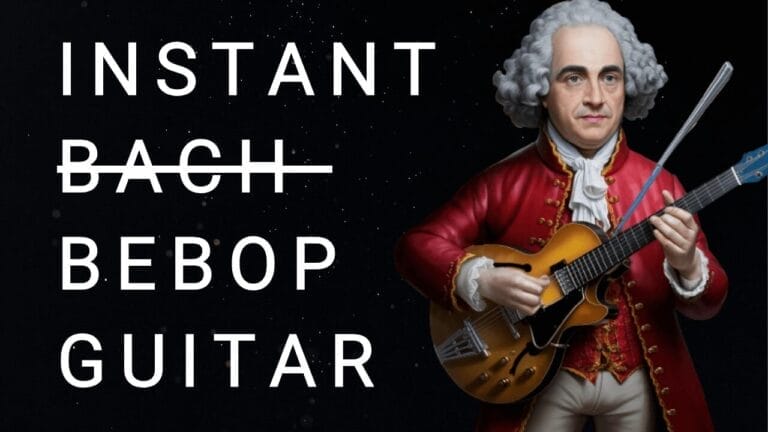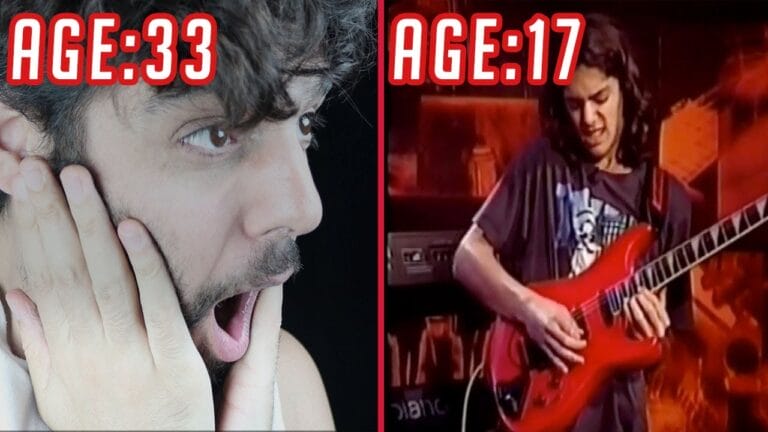Don’t Just Learn The Lick – Learn From The Lick!
One question I get a lot is once you learn a phrase, what do you do with it? So I’m gonna answer today how you can take one phrase and get the most out of it. So here we go. I’m just gonna take an E major phrase by Bach from his Partita—one of his Partitas and this beautiful book, Partitas and Sonatas. And the phrase goes like this. Very simple.
Analyzing the Phrase
The piece is in E major. Already, I can see that the triad
He is within the phrase. There’s an approach to the root. A part of the triad is there, and there’s this diatonic enclosure into the root again.So I’m gonna take this and just say out loud what’s going on. So that’s the first step. You can try to know what’s going on harmonically or harmonic numbers: root, seven, root, five, third, five, root, two, one, seven, root. Right? Just to know, to say it out loud.
Moving the Phrase to Different Areas
Then move it to other areas of the guitar. So you take the same notes and you find them in different areas of the guitar. Thus, you’re also getting different octaves by the way.
[Music]
So here’s one way of playing it, and you can also do
[Music]
You can also do it over here
Or here
And there’s probably a bunch of other ways. Yeah, so just being able to see it as what it is and not like it’s some visualization as a phrase that you can only play in one area.Diatonic Movement
Second thing you can do is move it diatonically. So, you know, after E major, and in the E major scale, you have an A major, and then you have F sharp minor right as the second degree. So that’s all about the diatonic awareness, you know, to have the diatonic mobility, so to speak.
So I’m going to take the same phrase and I’m going to move it to F sharp minor.
[Music]
So now I have the same application, same kind of sounding phrase, but I’m embellishing a second harmonic degree.
[Music]
Third degree
[Music]
Now we’re going to go to A major. It’s the fourth degree.
[Music]
B major
C sharp minor
And then I have the seventh degree, which is actually a diminished chord.
Right
[Music]
And I’m back to
Right. So that’s how I get the most out of phrases. And whenever I try to learn a phrase, even if it’s a jazz phrase, let’s take a bebop example. Or, you know, so if I take Charlie Parker
Right, and I take the A flat piece, Donna Lee.
He starts off with this
[Music]
So I’m gonna say out loud the harmonic numbers.
And, you know, first of all, note the harmony, and then say out the harmonic numbers. But if I just take the first chord A flat, I can see this kind of movement.Visualizing and Embellishing the Phrase
And then I can find this. Okay, I can see this as a first inversion of A flat. Right? You’re gonna know your triads. And then I also know how to see A flat over here. So I can embellish that phrase into this set of strings.
If you see it over here
Same thing
[Music]
So I, you know, I take the idea, the lick I learn, and I learn it in as many places as I can, you know, and really understand the construction of how it’s built. Oh, I see this is the first inversion phrase. Here’s the half step. Here’s a chromatic movement and from the six to the five. And maybe I’m doing this enclosure to the third.
[Music]
And then I can see it also over here. Right?Applying the Approach to Other Keys
So that really means that whenever you practice, not only do you need to know the notes on the guitar, but you also really want to know the functions of the notes you’re playing in order to get the most out of it.
Now, just like we did with the Parker, now we can do the same thing. We can move this kind of like, you know, construction to the next scale degree. For example, B minor, which is the second degree of A flat major, and you get this
Right
If here we had this approach and then the chromatic approach, and we added this enclosure into the third. Same goes to if we were on B flat minor. We would do this
Which is kind of like a movement, diatonic movement
From the root
To seven, then a chromatic approach from the six to the five
And then an enclosure, whatever we can come up with to land on the third
[Music]
So you see, that’s how I would take phrases and really get the most out of them.Conclusion
Um, I’ve been doing that for a few years now, and it’s been super transformative, you know, the way I learn from phrases. And I thought it’s an idea worth sharing today. So, um, hopefully, you got some value out of it, and I invite you to check out my Galactic Modern Guitar Program if you really want to go really deep into knowing the entire fretboard and the harmony and melody, arpeggios, and all that fun stuff. You can check it out in the link in the description.
As always, you can leave a comment and let me know what you would like to see in the next lesson. And thanks for being here. Be sure to subscribe and like this video to help, and I’ll see you later. Bye.
Whenever we find patterns, ideas, or movements in music, we can digest them deeply or half-heartedly.
Everything can be reduced to its simplest elements, from Bach’s arpeggios to Bird’s jazz bebop licks.
So, how do we digest a phrase and apply it to our own music?
In this video, I show you a few tips you can use whenever you learn a phrase or idea from a piece of music.
Follow these tips and you’ll learn musical ideas on the fretboard from a whole new perspective.



















